There is compelling evidence showing that environmental toxicity has detrimental effects on humans, the fauna, the flora, the Earth, and its climate.
The average American produces approximately four pounds of garbage daily. Municipalities have been having trouble relocating the waste. There have been attempts to burn garbage and dump it into the ocean, launch it into space, bury it in the soil, insert it in the food supply, footwear, clothing, accessories, etc. A sound and perfected solution has not yet been found. Garbage overload comes with wastefulness that is vastly due to excessive and mindless consumerism.

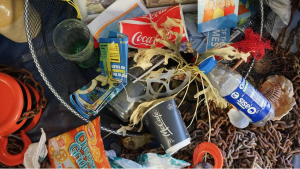
What causes environmental toxicity?
Based on the observation of staggering ecological changes that have occurred in the past few decades, the main causes of environmental toxicity have been identified as:
-
Chemical pollution
It includes the excessive littering of the eco-system with plastics, petrochemicals, radiation by-products, lead, asbestos, pesticides, mercury, cadmium, etc.
-
Improper disposal of household and industrial waste
Too much of the disposal is in the form of dumping that does not solve the pollution problem. Toxic materials are just moved out of the cities and dumped into the oceans or other parts of the planet.
Dumping of waste happens worldwide and has to do with the exportation of waste – mostly industrial, and sometimes hazardous — to areas with more lax standards about waste disposal and recycling. It contaminates the waters, the soil, and eventually the air. Dumping occurs:
a) On the land – The toxic waste contaminates the soil.
b) In the ocean – Contributing to oxygen depletion and the death of marine animal
Dumping causes wild life to suffer from all sorts of diseases and genetic mutations before dying. It has dire repercussions on the humans who eat animals, drink contaminated water, and eat food from the contaminated soil.
Environmental bio-hazards are severely affecting humans, animals, plants, and mineral life. They involve many stressors that come from various sources and have all types of reasons for being in the environment.
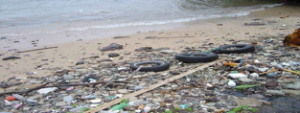
Problems with environmental toxicity
It encompasses a huge global issue that is difficult to control on all levels.
The most major problems with environmental toxicity happen to be:
Air pollution
Back in 2001, the EPA released studies showing that 36 people out of one million will get cancer from exposure to the air in America. From nano particles of chemical pollutants to mold spores, out-of-control pollen, and countless other organisms, the air we breathe can be very toxic depending on the areas where we live. Some areas are more polluted than others, and understandably, very large cities are the most polluted of all areas.
Water pollution
Most of our waterbeds are contaminated with environmental toxins, plastics, pharmaceutical by-products, and all sorts of contaminants. Bottled water, because it is not subjected to industry regulations is not necessarily a better choice for water consumption than tap water. In 1969, the Cuyahoga River in Cleveland caught on fire due to excessive man-made pollution from hazardous chemicals dumped into it. This caused new regulations to be passed in order to curb excessive water pollution.
Nowadays, our waters are polluted in ways that are hazardous to human and animal health. Marine animals often mistakenly identify plastic as seaweed.

This knowledge has motivated the bottled water industry to offer solutions in the form of packaged water. Now that just about everyone is buying stacks of bottled water, we are facing environmental pollution. People not knowing that plastic bottles litter the environment and take at least one thousand years to bio-degrade.
“The amount of plastic objects littering the ocean is twice the size of Texas”
Countless people are also not aware that bottled water has a hazardous side to it. Phthalates and Bisphenol-A (BPA), chemicals found in the plastic, leach into the water and cause harmful side effects known as hormonal imbalances and degenerative diseases such as cancer.

Soil Pollution
It is related not only to air and water pollution but also to chemical pollution and the dumping of toxic products, pesticides, herbicides, and other toxic products. A lot of the soil pollution comes from plastics of different grades. Plastic dumping is a huge issue. Many people overuse products that are bottled or packaged in plastics but do not properly recycle the waste that ends up littering the environment in ways that are very damaging.
Electromagnetic pollution
In the environment, electromagnetic pollution may come from high voltage electric fields, power lines, satellite towers, and miscellaneous aerosol pollutants. Electromagnetic pollution is associated with electromagnetic radiation which has been found to be responsible for DNA damage and degenerative illnesses such as cancer, Alzheimer’s Disease, etc.
Electromagnetic pollution involves what is known as “dirty electricity” in the form of dangerous electromagnetic fields (EMF) that have been found to cause cancer, leukemia, and other woes. There is electromagnetic pollution wherever there are appliances such as television transmitters, radio transmitters, microwave ovens, toaster ovens, refrigerators, hair dryers, electronic devices such as cell phones and their towers, computers, and all types of portable electronic devices. One can also process a significant dose of electromagnetic pollution just by riding in a car or traveling by air, rail, or water. The frequency level of the various electromagnetic fields determines how hazardous the exposure can be.
Noise pollution
It is a major problem in large cities, especially in the inner cities. There are different types of noise that range from industrial to harmful sonic frequencies, some of which are not always detectable. Noise pollution is everywhere, however it is much more prevalent in high density areas such as the cities that never sleep. Noise affects our sense of hearing and also our sanity.
Most of the detectable noise usually comes from: engines, heavy machinery, all types of vehicles, landing and ascending aircraft, trains, police vehicles, fire trucks, and ambulance sirens, loud sounds from broken car and motorcycle mufflers, loud radio playing, people, barking dogs, etc. It is always an unpleasant experience to be awakened in the middle of the night by loud, alarming noises.
In the inner cities in particular, where loud gun shots are commonplace, there is additional stress that assaults the mind and adversely affects hearing and peace of mind. Individuals who live near an airport, a highway, or railroad tracks can be subjected to severe noise pollution. In general, people living in areas of high population density are more likely to be the recipients of abuse from noise pollution than those living in rural areas.
Frequent and prolonged exposure to sounds higher than 85 decibels has contributed to hearing loss. Noise pollution leads to psychological disturbances, sleep disorders that eventually contribute to metabolic issues, premature aging, hearing loss, degenerative diseases and death.
People who are not aware of the connection between environmental toxicity and their own state of dis-ease often engage in littering that is a lack of cooperation toward environmental protection. It is akin to vandalism. The general overtone in toxic people’s behavior seems to be a focus on neglect and dissonance. A long-term observation of this type of behavior can sensibly lead to the conclusion that most of the behavior is virtually unconscious. A lack of resonance with living in harmony with nature engenders chaos. When people are disconnected from source energy, they are consequently disconnected from each other. Many humans subscribe to the belief that they do not see the need to have any regard for other people’s rights and sensibilities. That is one of the reasons why way too many people do not care and trash their own homes, vehicles, and city.
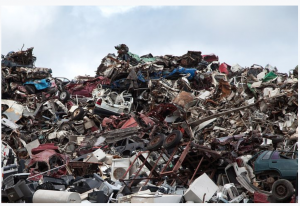
Chemical pollution
It is ubiquitous, and also the cause of many diseases and deaths in humans, marine life, wild life, and the destruction of bodies of water. It includes:
- Pesticides
There are different grades of pesticides and all of them are harmful. Pesticides get released in the waterbeds and leave residues on the soil and grass. They take a long time to biodegrade and get neutralized. These chemicals start breaking down after application, but their half-life is in average 60 days. The half-life of DDT is 15 years in the soil.
Moreover, pesticides mimic estrogens. An excessive production of estrogens leads to a larger than necessary generation of body fat, and that accounts for a large population of overweight people.
- Herbicides
They are commonly called ‘weed killers’ and are created to kill plant species that are regarded as ‘pesky’. The harmful properties of herbicides in humans, is well known. Studies have revealed that a particular type of herbicide known as Agent Orange is still causing congenital deformities in babies in Asia, years after their parents were exposed to the substance.
- Embalming ingredients
They are utilized to embalm corpses and eventually end up in the waterbeds and soil. Formaldehyde is one of the products used for that purpose. Quarternium-15 is a quarternary ammonium salt that has been said to have carcinogenic properties. It is found in many personal care products.
Funeral home operators have reported that there is so much overuse of artificial preservatives in the food supply and personal care products that human corpses now require 30% less embalming than thirty years ago.
- Radiation by-products
They are used by the medical profession for the chemical treatment of diseases.
- Fuel additives
They are in gasoline, and their very volatile nature makes them extremely absorbable by human and animal tissues. Repeated exposure or inhalation of fuel additives has been found to be responsible for health problems.
- Volatile Organic Compounds (VOCs)
They are known as organic chemicals that are pervasive and have a high vapor pressure at room temperature. They have been found to be hazardous to human life, animal life, and the environment. The following chemicals have been classified within the category of VOCs: chlorofluorocarbons, benzene, methyl chloride, perchloethylene, etc.
- Carbon Dioxide Emissions
Carbon dioxide (CO2) is the most major source of heat-trapping gas emitted in the environment through human activities. It is a toxic, poisonous gas. Its excessive emissions have been a reason for concern because it is believed to be responsible for climate change issues, and the greenhouse effect that is associated with global warming. Nowadays, the trees on earth, which normally are designed to filter the air, are demonstrating a lesser ability to reduce CO2 emissions.
Based on EPA statistics, CO2 emissions are produced mostly by electricity generation (38%), fossil fuel-based transportation (ground, air, and marine) (31%), industrial activity, mainly in the domain of the production of chemicals (14%), residential and commercial activity (10%), and non-fossil fuel combustion (6%).
- Synthetic fertilizers
They are used for farming and cattle raising. Cow’s flatulence contributes to excess methane gas production because of excessive cow burping. The way cows are raised for meat production is responsible for elevated carbon dioxide emissions. Methane gas is associated with CO2 production. In today’s times, the world’s population is eating more meat than perhaps necessary. The higher demand for meat causes an industry response for larger supply. Even though meat is nourishing, it is also intoxicating for the tissues. It takes a lot of CO2 producing energy to raise grain-fed cows compared to grass-fed cows. The U.N. Food and Agriculture Organization reported in 2006 that 18% of the world’s man-made greenhouse gas production was due to livestock. Elevated amounts of carbon dioxide (CO2) in the blood are indicative of health issues and an imbalance with oxygen.
- Petrochemicals
They are derived from petroleum that is used to manufacture plastics. They are present in almost everything: hair and skin care products, cleaning products, medical care products, and food.
Many people use plastic bottles then throw away the empty containers that some communities do not always properly recycle. Tremendous quantities of plastic bottles and containers end up on the shores, in the ocean, in other bodies of water, and in the soil. Plastic waste causes so much pollution that in the heavily industrialized areas of the planet, it is basically uncontrollable.
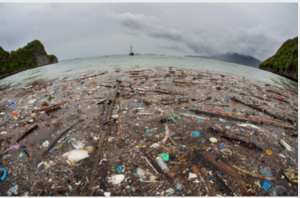
Plastic is extremely durable and may take at least one thousand years to start biodegrading. When plastics and other toxic materials are burned, the fumes contaminate the air and all life forms that breathe the air. Plastic by-products represent a major health hazard in people and animals due to the endocrinological issues they cause. Some of the main dangerous chemicals found in plastic water bottles are:
- Phthalates
- Bisphenol-A (BPA)
They are chemical compounds related to the manufacture of plastic products. They make plastics more durable and flexible. The are found in just about everything, in plastic water bottles, plastic containers of food, cosmetics, personal care products, children’s toys, backpacks, footwear, accessories, and much, much more. Scientific research studies show that phthalates and BPA contribute to:
- cancer and other degenerative diseases in humans.
- endocrine dysfunctions.
- gender-bender issues.
- xenoestrogens production in humans and animals, male and female.
- Inorganic chemicals
They are of different types and uses, for example:
a. Phosphates
Most laundry detergents and household cleaning products, paint, personal care products, and even processed packaged food. Phosphates are inorganic chemical compounds containing phosphorus. Many rivers and streams have been drying up due to excessive amounts of phosphates in the water supply.
b. Chlorine
Even though chlorine is a necessity that municipalities routinely use for water disinfection, it also has side effects. In institutions, commercial venues and households, chlorine is used for cleaning, disinfection, and bleaching. Even in extremely diluted amounts, prolonged and frequent use for water disinfection, showering and swimming poses risks of cancer and health issues such as thyroid dysfunction leading to excess weight gain.
c. Nitrogen
It is often used in crop fertilization and for other industrial purposes. Sulfites and sulfates that derive from nitrogen are heavily used in the personal care industry for the manufacture of hair care and skin care products. Sodium lauryl sulfate and sodium laurel sulfate (SLS) have been found to be carcinogenic.
d. Mercury
A chemical element used in dentistry and other industries. Its vapors can cause very serious health problems. It used to be an essential part of thermometers but has been banned for a few years now. Mercury also enters in the manufacture of some compact fluorescent light bulbs.
e. Cadmium
A chemical element found in batteries. When improperly disposed of, cadmium makes its way into the waterbed and soil, adversely affecting our food production.
f. Lithium
When lithium batteries are improperly disposed of, the soil and water do become contaminated by this heavy metal. Even though in micro doses, bioavailable types of lithium are useful as medicine, excessive exposure to lithium leaking from batteries in the environment can cause toxic overload and eventually overtax the body.
g. Lead
It is a highly toxic metal found on the earth’s crust and also in man-made items. The main problem with man-made items is their improper disposal or recycling. Exposure to lead has caused numerous types of illnesses, both physical and behavioral. It has been responsible for genetic damage and birth defects. Lead is included in paint, cellular phones batteries, certain types of glass, some cosmetics (particularly lipsticks, foundation, and eye shadow). Lead is also present in some electrical cords and wiring materials. Batteries represent 80 percent of the lead supply worldwide; lead emissions are 20 times higher in Mexico than in the US.
Special Interest Groups and Misinformation about Environmental Pollution
Some smart alecks have argued that everything that exists on the planet is natural because it originates from nature. Not everything considered natural is healthy however. Plastics originate from the petroleum that is extracted from the earth. Most of them unfortunately also come with irreversible side effects on human and animal health, no matter how natural they are considered to be. Some synthetic foods, such as processed cheese, are often one molecule away from plastic.

Solutions to Environmental Toxicity?
The solutions to environmental toxicity are vastly under-utilized due to a lack of awareness. The planet may not be sustainable in 30 years if solutions are not conscientiously implemented. For the human specie to make a dent in the eco-toxicity issue, it is imperative that all people commit to practice the following principles:

Since we are what we breathe, eat, drink, feel, hear, see, touch, and think, it is our prerogative to educate ourselves on what comes in contact with our body. The reason for doing that is because toxic pollutants usually have detrimental implications on our health and behaviors. An education campaign on environmental protection — that also entails self-protection — can eventually lead to increased awareness, and perhaps a better solution to the pollution toxicity.
Sri Regine Lherisson-Bey is a Mind-Body Therapist, Wellness Coach, and Author voted Wellness Expert by peer consensus in 2005. Therapist Lherisson-Bey is the author of the Kindle bestseller HOW TO DETOXIFY YOUR LIFE NATURALLY as well as the weight management program GET SLIM EFFORTLESSLY that has evolved from CD to an instructional picture book and eBook.
For more information, check: https://wholenessconnection.org/welcome
Help support our mission:
If you have found this article helpful and would like to send a donation as a gesture of appreciation, please click on this link:
https://www.paypal.com/cgi-bin/webscr?cmd=_s-xclick&hosted_button_id=6H9XL8NGSATRU&source=url
| Facebook YouTube Twitter Google+ |
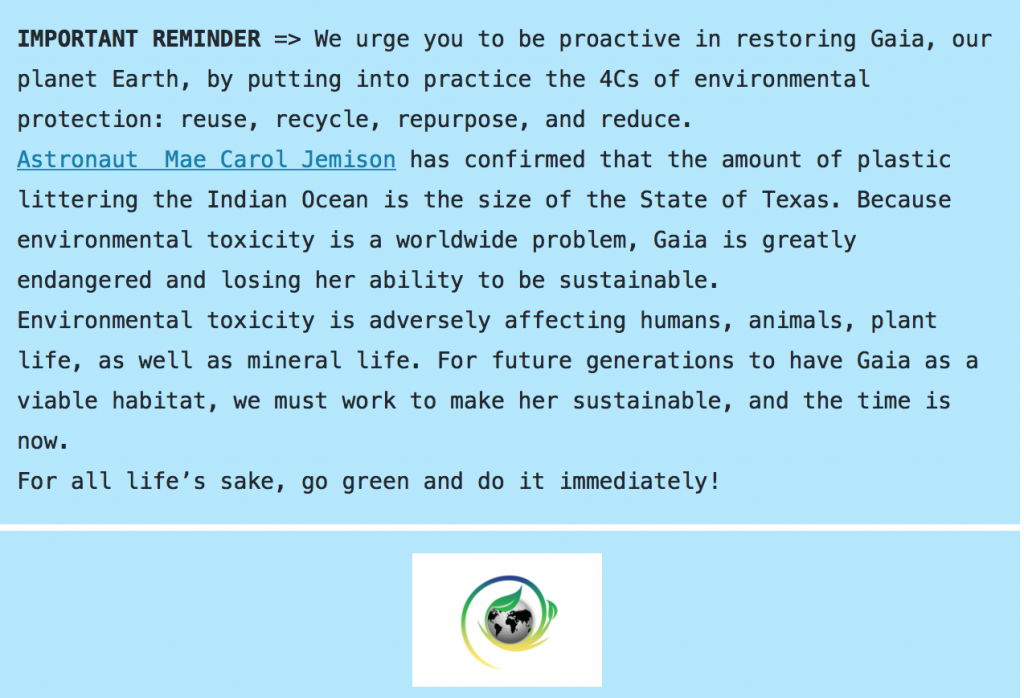
Content Disclaimer: The information contained in this post may not be interpreted as medical advice. Read full disclaimer here…
Photography credits: CreativeCommons.wikimedia.org; pixabay.com
Copyright (c) 2019 and beyond Sri Regine Lherisson-Bey. All Rights, Liberties, and Remedies Reserved . UCC 1-308.